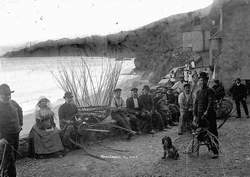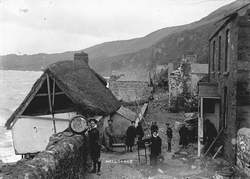As well as quoting from their interviews with individual residents reporters would sometimes comment upon the psychological reactions of the villagers. Indeed on Wednesday 23 September 1903, a few days after major storms, the representative of the Western Daily Mercury asserted that “The Hallsander is a study for the psychologist at this moment.” The reporter was puzzled that “The man is in deadly peril ― he says so himself ― and all the while he goes about his daily task with consummate indifference.” He had observed that despite some anxiety there was “not a trace of excitement to be found anywhere”. He speculated that the possibilities of the situation had not yet been appreciated, but immediately acknowledged this could not be true as he had heard a number of men discussing the prospects of the whole village being eventually swept away. He was more willing to attribute their calmness to the inherent fortitude of their race and calling.
On 14 December 1903, after further damage had been inflicted, the Western Morning News reported that things were indeed gloomy out at Hallsands. The gloom was enhanced by the fact that the villagers themselves were unable to do anything to help themselves, being totally reliant on assistance and funds from elsewhere.
Less than two months later, the WMN’s representative found that the fishermen were in a more despondent state than at any time since the village was threatened. They considered that the new sea wall would not stand, that the money spent on it was practically wasted. It would have been better to spend the money on building a new village at a spot further inland. They now believed that nothing could save the present village.
On 21 March 1904 the reporter identified by the initials AES again observed the patience and sense of resignation among the villagers. He did, though, wish to lodge one complaint against their impassivity, that they could have done more to help themselves. They could, for example, have collected the larger stones on the beach to prevent them being driven against houses and walls during the rougher high tides. He realised, however, that any initiative was paralysed by the sense of injustice felt by the villagers, together with their despair of any return to days more prosperous. AES also noted the use of humour by the villagers. One of them remarked that the beach had not disappeared, but “they had took it away to Plymouth”.
Another theme running through the press reports of 1903-
Inhabitants of neighbouring villages on the coast, especially Beesands and Torcross, were connected to the people of Hallsands by ties of marriage and their shared engagement in the fishing industry. From time to time the newspapers would describe the help they offered in removing furniture and possessions, and in providing temporary accommodation.
Two individuals who gave important support to the people of Hallsands were Frank Mildmay, MP, and R Hansford Worth. Their contributions were fully acknowledged by the press. For example, the Western Morning News reported in detail on a visit made by Frank Mildmay to Hallsands on 16 October 1903 to see at first hand the recent damage. There was a meeting with local people in the reading room, when “Mr Mildmay, who was enthusiastically received, said that he was exceedingly glad that an opportunity had presented itself for himself to see what was really going on at Hallsands. He recognised that it was always better to see for oneself rather than take all that was said by authorities (Hear, hear.)”
On 2 February 1904 the WMN published a very long letter from Frank Mildmay in which he described his negotiations with the Treasury, the Board of Trade, and Sir John Jackson over the amount of compensation to be paid to the villagers. He had succeeded in increasing the total amount to £2000, a sum that included £250 donated by himself. As it happens, this amount was not accepted by the villagers, and, as mentioned earlier, it was afterwards further increased to £3250, including Mildmay’s own donation.

